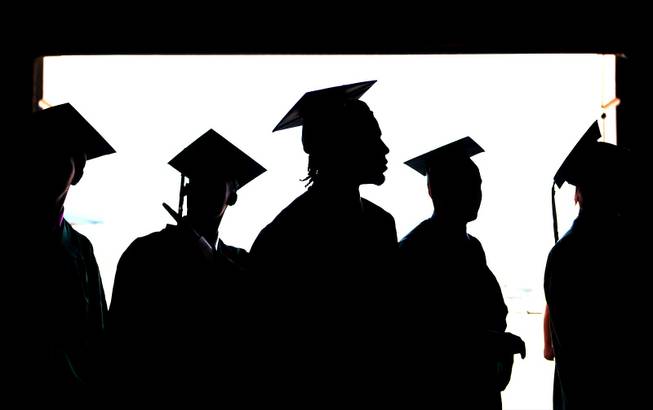
Boys line up backstage during the Chaparral High School commencement ceremony at the Orleans Arena on Friday, June 15, 2012.
Tuesday, Jan. 22, 2013 | 4:22 p.m.
Related story
Nevada is unlikely to increase its graduation rate to the national average over the next decade, according to a federal report released this month.
The Silver State produced 23,493 public high school graduates during the 2010-11 school year, which represented a graduation rate of 62 percent — the lowest in the nation.
A new report by the National Center for Education Statistics estimates Nevada's graduation rate won't make the national average anytime soon.
It's not for a lack of effort. The number of high school graduates in Nevada surged nearly 31 percent between the 2003-04 and 2008-09 school years, and the U.S. Education Department is anticipating similar growth over the next decade.
By the 2021-22 school year, Nevada is projected to produce 26,380 graduates, according to the federal Projections of Education Statistics to 2021 report. That means Nevada's graduation rate will improve to about 70 percent – up from the current 62 percent.
However, Nevada still will be well short of the 30,313 graduates it needs to reach an 80 percent graduation rate, a goal set by Jim Guthrie, Nevada public schools superintendent. Currently, the average graduation rate nationally is 75.5 percent.
The challenge of improving Nevada's graduation rate will be compounded by the fact that the Silver State will likely face a continuing influx of students.
Nevada is projected to have about 528,000 public school students in 2021, up from 439,277 students last school year, according to the report.
That means Nevada's student population will shoot up 20 percent over the next eight years. For comparison, public school enrollment nationally will grow only by 7 percent between 2010 and 2021, according to the report.
Much of this growth will come from the rising Asian and Hispanic student populations, both of which are expected to jump by about 25 percent between 2010 and 2021 nationally, according to the report.
The number of black students is expected to go up about 5 percent, while the number of white students is projected to decline by about 2 percent nationally. The number of multiracial students will surge by 34 percent, according to the report.
Here are some other key findings from the federal report:
• There were 55 million K-12 students in American public and private schools in 2010, which represented a 6 percent increase from 1996. Most of the growth was in public schools; private school enrollment fell 9 percent over the same period.
• The West is expected to have the largest student growth over the next decade: a 13 percent increase. The South is projected to see a 9 percent increase, while the North and Midwest will experience a 2 percent increase.
• The number of high school graduates nationally increased by 29 percent between 1996-97 and 2008-09 school years. This figure is projected to increase by 5 percent leading up to the 2021-22 school year.
• The number of public schoolteachers nationally grew 20 percent between 1996 and 2010. This figure is projected to grow about 15 percent leading up to 2021.
• The student-teacher ratio nationally fell from 17:1 to 15:1 between 1996 and 2010. This figure is projected to decrease by 14.4 percent by 2021.
• New teacher hires are expected to swell from 301,000 in 2010 to 384,000 teachers in 2021, an increase of about 28 percent.
• Public school spending nationally is expected to rise 24 percent between the 2008-09 and 2021-22 school years, which is a significantly lower growth rate than the 42 percent increase over the past 12 years.
• The average per-pupil spending is projected around $12,530 during the 2021-22 school year, a 15 percent increase from the 2008-09 school year. Currently, Clark County spends about $8,252 per student.
• College enrollment, which has leapt 46 percent between 1996 and 2010, is projected to slow its pace to 15 percent from 2010 to 2021. The federal government anticipates 24 million college students in 2021.
• Over the next decade, colleges are expected to confer a record-high number of degrees at all levels. Furthermore, for the first time in history, colleges are expected to produce more female than male doctoral graduates.
• Over the last two decades, the number of female college students has outpaced the number of male college students. The federal government expects this gender gap in student enrollment to widen over the next decade.

Join the Discussion:
Check this out for a full explanation of our conversion to the LiveFyre commenting system and instructions on how to sign up for an account.
Full comments policy